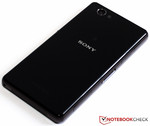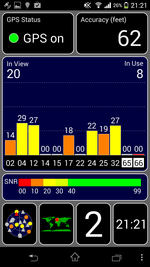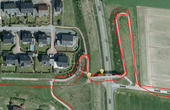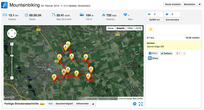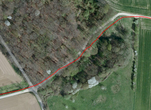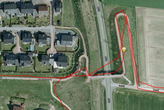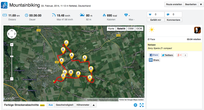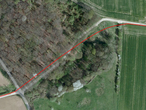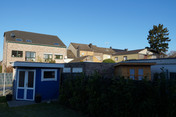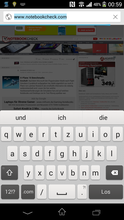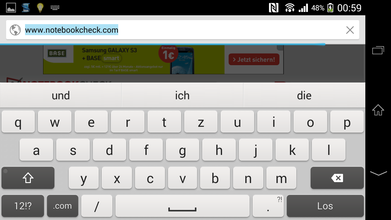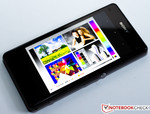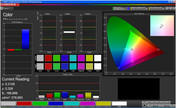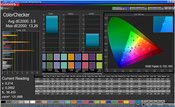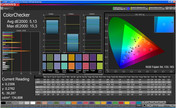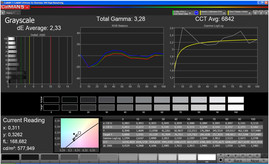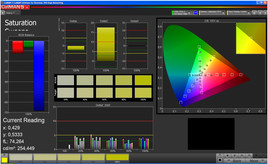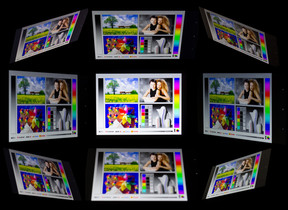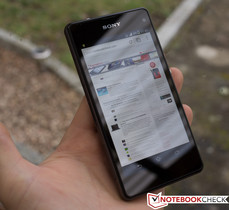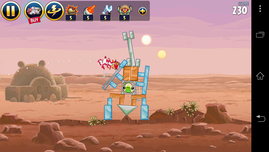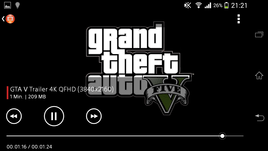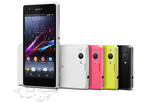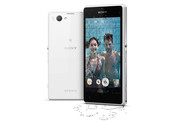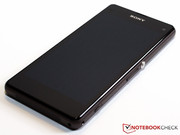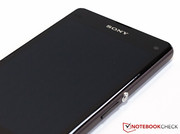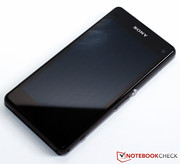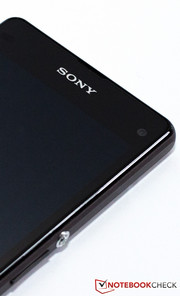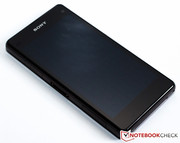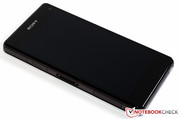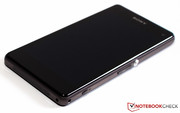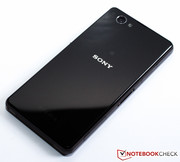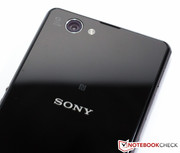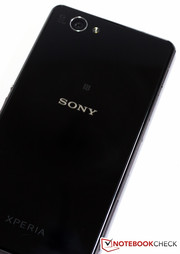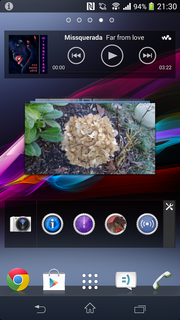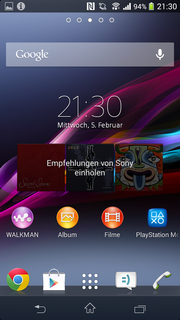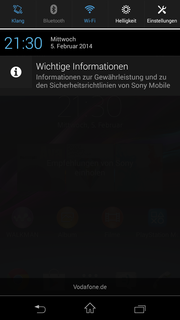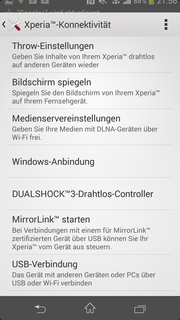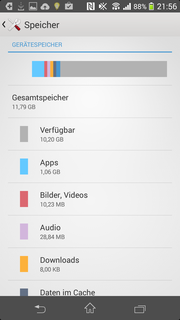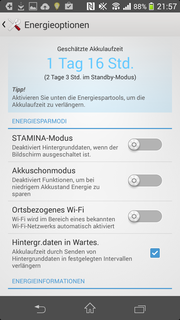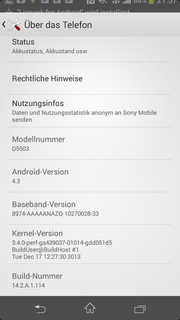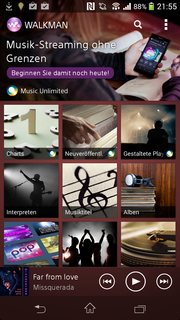Review Sony Xperia Z1 Compact Smartphone
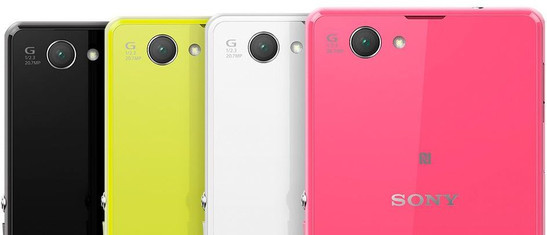
For the original German review, see here.
A manufacturer has finally succeeded in launching a smaller version of a premium top-seller on the market featuring almost the same innards. HTC's One Mini and Samsung's Galaxy S4 Mini are also "compact" smartphones named after their larger flagships. However, to the dismay of many, these devices only have the name and similar looks in common. Sony takes a different approach with its Xperia Z1 Compact, and squeezes the hardware of its bigger brother in a smaller casing. It also sports the extremely high-performance Snapdragon 800 with a clock rate of 2.2 GHz per core. The screen has shrunk to 4.3 inches, which affects the resolution. Unlike the Xperia Z1, a screen with an HD resolution of 1280x800 pixels is installed in the smaller edition. The difference between both phones should theoretically be quite marginal - particularly in terms of performance. Read in our test whether theory equals practice.
Case
Those who have held the Z1 in their hands will find the build quality and choice of materials familiar. It is again a scratch-resistant mineral glass, although we are always wary of words like "scratch-resistant" or "waterproof" in connection with smartphones. We have been testing the Z1 Compact for ten days now, and we can say that this period of use has not passed without leaving signs on the casing. The significant differences of the review sample are its dimensions and weight. The bigger model weighs 169 grams (~6.0 ounces) with a width of 74 mm, length of 144 mm, and a thickness of 8.5 mm (2.9 x 5.7 x 0.3 inches). Naturally, several cuts were made in width and length (64.9 x 127 mm; 2.6 x 5 inches), but not in thickness. The casing has been blown up by 1 mm, but the weight could be reduced to 137 grams (~4.8 ounces) (HTC One Mini: 122 grams; ~4.3 ounces). As known from Sony, this smartphone is also water (IP55 & 58) and dust resistant (IP55).
Connectivity
The positioning of buttons and slots has only been modified insignificantly. As before, the open, 3.5 mm jack is on the upper edge. The centered power button, volume rocker, and camera release are on the right. The Xperia Z1 also has the micro SIM slot on this side. But here, it is on the casing's left, just like the micro-SD slot, micro-USB port, and docking port. The speaker reserves almost the entire width of the Z1 Compact's lower edge.
Software
Android 4.3 is already installed here. Of course, Sony insists on overlapping the Android interface with its specially developed user interface (UI). This includes numerous pre-loaded apps that can only be deleted with some effort.
Communication & GPS
Seeing that the SoC in our review sample is identical with the one in the full-size model, the number and quality of communication modules have not been modified greatly. The Wi-Fi module also supports the 802.11 a/b/g/n/ac standards, and can transmit in dual-band mode. We also experienced minor problems with the transmission range here. The smartphone uses the LTE (download up to 150 Mbit/s) or the UMTS network when not connected.
The Z1 Compact uses its aGPS module (including GLONASS support) for accurate localization. Our review sample cannot compete, however, with Garmin's Edge 500 outdoor navigation system. This did not surprise us because the Z1 also struggled in this sector. In the smartphone category, both the iPhone 5S and iPhone 5C have an unchallenged lead in regards to localization.
Telephony & Speech Quality
Although the portable companion can replace many functions of a laptop or computer, its original purpose is telephony. The Z1 Compact does this without faltering, and even thrills with an impeccable speech quality. The test calls were not affected by any interference noises, and the volume during calls did not give any reason for complaint. The included headset sensibly completes the functionality even if the headset's quality is not completely convincing.
Cameras & Multimedia
The Z1 Compact's primary camera has a resolution of 20.7 megapixels. This extremely high rate sounds familiar to us because it is, of course, the same as the one in its name-giver. The camera modules in both smartphones are identical. Logically, it is not very surprising that the taken sample pictures show a barely visible difference.
Here, we have to point out again that the Exmor RS sensor in both Xperia Z1 models does an outstanding job. The colors are natural, and the sharpness is impressive.
Accessories & Warranty
Apart from the phone itself, there are many instructions in paper form, the modular power supply, and the in-ear headset in the box. Other accessories, such as a docking station, are optionally available.
Similar to the big Z1, the manufacturer includes a warranty period of up to 24 months. However, the battery and included accessories are only covered for 12 months in case of accidental damage.
Input Devices & Controls
The phone's main control is the capacitive touchscreen. It can deal with up to ten inputs at the same time, responds accurately and very fast. The virtual keyboard takes up about half of the visible screen on the 4.3-inch display. It is even tighter in landscape mode. Barely anything is visible alongside the word suggestion feature. Nevertheless, we did not notice any significant differences compared with the Xperia Z1 - both phones work flawlessly.
Display
The biggest difference between the Xperia Z1 and our review sample is the screen size. It is 0.7 inches smaller, and the resolution is thus lower. 1280x800 pixels result in a pixel density of 351 ppi. Sony manages to improve the average brightness by over 70 cd/m² to now 569.2 cd/m². The illumination has also been upgraded; the screen exhibits a very homogeneous illumination of 92%. The next highlight follows without delay; Sony has also dug deep in the bag of tricks regarding the black level. The manufacturer succeeded to halve the Xperia Z1's black level. Along with the screen's brightness, the Z1 Compact ultimately achieves a contrast of 1295:1 - kudos are due because rarely are all screen qualities on such a high level.
| |||||||||||||||||||||||||
Brightness Distribution: 92 %
Center on Battery: 570 cd/m²
Contrast: 1295:1 (Black: 0.44 cd/m²)
ΔE Color 5.13 | 0.5-29.43 Ø5
ΔE Greyscale 2.33 | 0.57-98 Ø5.3
Gamma: 3.28
The screen is also compelling in the assessment with CalMAN 5. Although a bluish cast is evident, the DeltaE in ColorChecker is just 3.9, and the DeltaE in Grayscale is 2.33. The grayscale reproduction is not congruent with the ideal line, but the deviations are not massively irritating.
The screen can fully exhibit its many advantages in this department. It is extremely bright, and features a very high contrast - the only thing standing in the way of a perfect score is the screen's reflective glass.
Performance
A Snapdragon 800 MSM8974, an Adreno 330, a clock rate of 2.2 GHz per core (quad-core), and 2 GB of working memory - any questions? These specs should indicate a clear direction even before performing the actual benchmarks. The Z1 Compact is a model from the very top of the premium range and promises abundant power. This hardware combination is found in many competing models and convinces once again.
| 3DMark - 1280x720 offscreen Ice Storm Unlimited Score (sort by value) | |
| Sony Xperia Z1 Compact | |
| Sony Xperia Z1 | |
| Google Nexus 5 | |
| Motorola Moto G 1. Gen XT1032 | |
| Epic Citadel - Ultra High Quality (sort by value) | |
| Sony Xperia Z1 Compact | |
| Sony Xperia Z1 | |
| LG G2 | |
| Google Nexus 5 | |
| Motorola Moto G 1. Gen XT1032 | |
| Geekbench 3 | |
| 32 Bit Multi-Core Score (sort by value) | |
| Sony Xperia Z1 Compact | |
| Sony Xperia Z1 | |
| LG G2 | |
| Google Nexus 5 | |
| Motorola Moto G 1. Gen XT1032 | |
| 32 Bit Single-Core Score (sort by value) | |
| Sony Xperia Z1 Compact | |
| Sony Xperia Z1 | |
| LG G2 | |
| Google Nexus 5 | |
| Motorola Moto G 1. Gen XT1032 | |
| AnTuTu v4 - Total Score (sort by value) | |
| Sony Xperia Z1 Compact | |
| Sony Xperia Z1 | |
| LG G2 | |
| Google Nexus 5 | |
| Motorola Moto G 1. Gen XT1032 | |
The results in the synthetic benchmarks speak a very clear language. The Z1 has the lead in virtually every test, and can partly clearly surpass the contenders. Even the 5-inch original barely stands a chance against the Mini edition.
| Octane V2 - Total Score (sort by value) | |
| Sony Xperia Z1 Compact | |
| Google Nexus 5 | |
| Google Nexus 5 | |
| Peacekeeper - --- (sort by value) | |
| Sony Xperia Z1 Compact | |
| Sony Xperia Z1 | |
| LG G2 | |
| Google Nexus 5 | |
| Apple iPhone 5S | |
| HTC One Mini | |
| Samsung Galaxy S4 Mini GT-I9195 | |
| Nokia Lumia 1520 | |
| Motorola Moto G 1. Gen XT1032 | |
| WebXPRT 2013 - Overall (sort by value) | |
| Sony Xperia Z1 Compact | |
| Sony Xperia Z1 | |
| LG G2 | |
| Google Nexus 5 | |
| Apple iPhone 5S | |
| Apple iPhone 5S | |
| Nokia Lumia 1520 | |
| Motorola Moto G 1. Gen XT1032 | |
| Browsermark - --- (sort by value) | |
| Sony Xperia Z1 Compact | |
| Sony Xperia Z1 | |
| LG G2 | |
| Google Nexus 5 | |
| Apple iPhone 5S | |
| HTC One Mini | |
| Samsung Galaxy S4 Mini GT-I9195 | |
| Nokia Lumia 1520 | |
| Motorola Moto G 1. Gen XT1032 | |
* ... smaller is better
The formerly achieved, extremely positive scores are put back in perspective in the browser-based runtime tests. Although the scores are still on a high level, the contenders frequently take the lead this time. Even the considerably more sparsely equipped Moto G can surpass the Z1 Compact in "WebXPRT 2013" - by as much as 46%.
The Z1 Compact gives everything in the flash memory's speed assessment. The extremely swift storage in both the LG G2 and Moto G give the review sample a hard time; nevertheless, the score is once again outstanding. Sony apparently beefed up the performance considerably, and squeezes the last drop out of the compact, high-end phone.
Games & Videos
The installed SoC actually makes this test section superfluous. The Snapdragon 800 has so much power that no current game could push this device to its performance limits. We nevertheless checked this thesis using various games from the Play Store. Our assumption proved right.
The SoC is certified for rendering QFHD contents, and does this task well as expected. All tested trailers could be played without problems, and did not produce any artifacts or other ugly side effects.
Emissions
Temperature
The temperature development during load did actually surprise us. Sony has managed to optimize the heat dissipation to such an extent that the Z1 Compact operates with lower temperatures than was the case in the bigger model - and that despite the casing's smaller volume. We measured between 35 and 38.4 °C (95 and 101.12 °F), in contrast to the larger model's 35.8 to 39.1°C (96.44 to 102.38 °F). Even more astonishing is the direct comparison with HTC's One Mini (41.1°C; 105.98 °F), and Samsung's Galaxy S4 Mini (38.1°C; 100.58 °F) because both phones have a much lower performance and lower clock rates. Just as excellent is the temperature development in the idle scenario. The average temperatures on the back and front clearly settle to below 30 °C (86 °F). Although we measured similar temperatures on the One Mini (29 °C; 84.2 °F) and Galaxy S4 Mini (28.4 °C; 83.12°F), the Z1 is again unrivaled - full score!
(+) The maximum temperature on the upper side is 39.8 °C / 104 F, compared to the average of 35 °C / 95 F, ranging from 21.9 to 56 °C for the class Smartphone.
(+) The bottom heats up to a maximum of 39.3 °C / 103 F, compared to the average of 33.8 °C / 93 F
(+) In idle usage, the average temperature for the upper side is 28.8 °C / 84 F, compared to the device average of 32.7 °C / 91 F.
Speakers
The elongated speaker on the lower edge suggests quality, and gives hope for a pleasing sound experience. Well, it is an experience, though not really a good one. The sound is tinny, and lacks depth even in low volumes. Of course, this impression does not improve at higher volumes - rather the opposite. This is the first drawback, because the Z1 Compact was throughout exceptional until now.
Energy Management
Power Consumption
The Z1 Compact benefits from its small screen in this section. The 5-inch edition consumed between 1.2 and 2.2 Watts during idle, and 3.9 to 5.7 Watts during load. Although it sports the same hardware, the Z1 Compact is considerably more frugal. We recorded the biggest difference in full load where the review sample only consumed 4.1 Watts. Compared with the One Mini and Galaxy S4 Mini, the three phones are only on par in the load scenario. The Snapdragon 400 in both contenders is satisfied with significantly fewer Watts when idling.
We measured 0.1 Watts when the Z1 Compact was on standby, and the Voltcraft VC 940 did not record any consumption when the phone was completely off.
| Off / Standby | |
| Idle | |
| Load |
|
Battery Runtime
The marathon-runner among smartphones. The 2300 mAh battery is quite generously sized for such a "compact" device. Even if the bigger model's battery adds up to 3000 mAh, it does not stand the slightest chance against the Z1 Compact's extreme battery runtime. The battery lasted for over 40 hours in idle, and we measured an equally very enduring runtime of just over 19 hours in the Wi-Fi scenario. The Z1 Compact still managed 3 hours and 28 minutes when all wireless modules were enabled, the screen's brightness was set to maximum, and the SoC was fully loaded. Thus, the small premium phone outperforms the 5-inch edition in all departments, and even the contenders can barely compete with such runtimes. The battery cannot be removed because the casing is certified according to IP standards (water and dust resistant).
Verdict
Sony fulfills the wish of many customers with the Xperia Z1 Compact because these "Mini" versions were only available with stripped down hardware (see HTC's One Mini, Samsung's Galaxy S4 Mini). The Z1 Compact, however, not only uses the same SoC as its bigger brother (Qualcomm Snapdragon 800); it also even eliminates some of the Z1's shortcomings. It can be generally said that Sony has managed to install a better screen in every respect: It is brighter, has a better contrast, and the viewing angle is very stable. Another plus is the battery runtime. A runtime of over 40 hours is exceptionally long.
Buyers flirting with the Xperia Z1, but who are in doubt about its size, might want to look closer at the Z1 Compact. It comes with the same advantages of the bigger model, and even mends its drawbacks. Its current purchase price of 499 Euros (~$683) is not a bargain, but premium hardware has its price. A look at Motorola's Moto G could be worthwhile should the budget be tighter - stripped down hardware for a more than fair purchase price.


 Deutsch
Deutsch English
English Español
Español Français
Français Italiano
Italiano Nederlands
Nederlands Polski
Polski Português
Português Русский
Русский Türkçe
Türkçe Svenska
Svenska Chinese
Chinese Magyar
Magyar